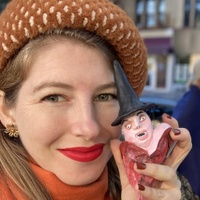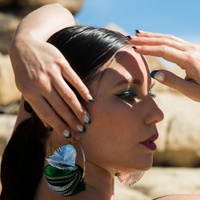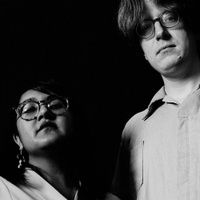As told to Ariel Courage, 2813 words.
Tags: Art, Comedy, Process, Beginnings, Day jobs, Multi-tasking, Mental health.
On avoiding creative stagnation
Multidisciplinary artist Lauren Cohen discusses creating a workable routine, day jobs as sources of inspiration, and the value self-knowledge.You’re a ceramicist, sculptor, writer, graphic novelist, filmmaker, and performance artist. How do you juggle these different forms?
My work comes from a foundation of painting and drawing. Over time, I felt I needed to expand my practice to include writing, ceramics, comedic performance, and film. I tend to move in and out of these forms. They seem separate, but in the end, I make cohesive installations. My practice is project-based, so I start with one idea or concept and develop it.
My daily life, observations, and research inform a drawing practice. Since I moved to New York in 2018, I’ve had this routine of going to draw every day at a coffee shop in my neighborhood. Over the course of a year–sometimes longer, a year and a half to two years–I compiled these drawings into a cohesive graphic novel.
From there, I choose characters to flesh out. The ceramics I sculpt are objects I imagine that character would use. Sometimes, those objects appear in the drawings; other times, they’re made up in my mind. I’ll film these comedic vignettes with them.
All of that together is what an installation would be for my work. The final part of the whole process is writing about all of it.
Walk me through that realization of needing to branch out beyond painting and drawing.
I felt that just making paintings wasn’t theatrical enough. My childhood was filled with comedy and performance. Growing up, I’d make these strange little stage sets. All these objects I already had in my room, like Breyer horses or Troll dolls, would go into making scenes in this fantasy world.
As I developed my practice, I started realizing that I wanted to revert to that childlike behavior to add layers of comedy to my work that were missing in the paintings. The paintings were too serious, too dark. I needed to go to these other art forms in order to get that humor back.
Can you expand on the importance of humor in your work?
From early childhood, you need to have an outlet of humor, or else the challenges of your home and upbringing become too heavy. My research in trauma and early childhood development delves into that idea.
When I was a kid, I used to dress up as these different characters. For example, I created a character named Bageeta who’d had a lot of work done on her lips. She couldn’t talk very well. My parents encouraged me and filmed me as this character. It provided a lot of comic relief for us. There are photographs and footage of me at the age of 6 or 7, doing this. We used to vacation in Maine, and I had created several male characters who were obsessed with L.L. Bean and boiled lobster.
As I’ve gotten older, I’ve found comedy troupes to follow in any city I’ve ever lived in. Every week I go to a show. I go by myself and sit in the back, away from everyone, immersing myself in the routines and appreciating them as the comedian’s artistic outlet.
I find so much value in how a comedian interprets existential dread, depression, and trauma. Here in New York City, I follow Butterboy, which happens every Monday night at Littlefield. Also, I work for SNL as a cue card girl. That’s an added layer of putting myself in an environment where comedy reigns.
How did you get on the visual art track, as opposed to the stand-up or actor’s path?
I was exposed by my family to different kinds of art. We went to openings and museum events. There are artists in our family, but they were painting traditional landscapes reminiscent of Andrew Wyeth.
One time when I was young, my aunt took me to a Tim Burton exhibit in Los Angeles at LACMA. It was incredible to see his multidisciplinary practice. He sculpts and draws and makes films. His practice is just so broad. I didn’t know at that time how I was going to pull all of my visions together to make a similar installation, like a cohesive universe with all of my art forms. But that was a huge influence.
It’s interesting that you name him as an influence, because your work is funny but also kind of terrifying, which could be said of Burton too. Are there other influences that inform your practice?
I’m from Danvers, Massachusetts. The foundational ideas in my practice come from growing up there and not fitting in. I was an outsider, and experienced bullying, harassment, and abuse. This might be controversial, but I feel not much has changed almost 400 years later. Obviously, there aren’t public hangings anymore, but it’s still puritanical, patriarchal, and repressed. When I turned 18, I left. I have nostalgia for the place, but growing up there was a huge door opening to this understanding of what humans can do to each other. It’s where some of the darkness in my work comes from.
I was also influenced by the theatrics of Halloween in the neighboring town of Salem: haunted houses and hayrides, seances, people dressing up with masks, etc. There was a cemetery in our backyard with these weathered, slumped-over headstones, and my mom had a Ouija board that I used to–or so I thought as a child–communicate with the dead. There’s humor and whimsy in that; it’s not that I put a lot of weight into the realness of it. I’m interested in how people are so titillated and entertained by horror that it becomes commodified. I also think growing up in that environment, where I didn’t socialize well with other kids, caused me to retreat into a fantasy world of invented people. I think it was necessary for me to have my artistic universe at that pivotal time so I could thrive.
I was always creating out of a necessity to process or cope. My practice melds my own background and development, insecurities, mental health, failures, frustrations, sexuality, misunderstandings, and everything in between. It’s a purge. My hope is that when people look at the work, they’re not shocked or turned off by its overt sexuality. I’m thinking of Robert Crumb or Aline Kominsky-Crumb, and their practices of exposing personal truths of what they ruminate on. It can seem kind of “out there” to the general public.
When the pandemic hit, I was feeling isolated, but I wanted to be able to show my work in a gallery. My reasons for moving to New York were to further my career and to find love.
I set up these booths in my neighborhood in Park Slope and put my sculptures, drawings, and graphic novels out. I got two reactions: either people laughed, or they felt uncomfortable and scurried off. I was trying to expose the inner things I thought about and was ready for all reactions.
It seems like your work combines the revulsion and the comedy of raw exposure, showing every facet through these various media.
That’s the best part of it. Now that I’m starting to have shows, the feedback from viewers has been that they feel a lot of the content is relatable. This is helpful, because prior to moving to New York in 2018, I was really keeping so much hidden, and my work didn’t expose these layers of vulnerability.
In my graphic novels, which combine autobiography and fiction, I continuously draw this female character in her late 30s, who’s always naked. Removing her clothes was supposed to be an attempt to be as vulnerable and raw as possible.
I’m in therapy, and a lot of my work from sessions gets funneled straight into my practice. It is heavily psychological. I find it helpful to open these avenues of my interior thoughts and put it out there. People are then like, “Oh, I have that issue too,” or “Oh, I think about that a lot,” or, “I’ve been there before.” Then it helps because you’re like, “Oh, wait, I’m not all by myself in this?”
It’s comforting, even as it’s uncomfortable in a weird way. Can you talk a little more about what your average day or week looks like as a person making art?
I wake up and do remote fitness with my dad. We started doing this during the pandemic. It’s been helpful for healing our relationship. We talk about life and art. We have lengthy conversations that go in tandem with what I’m dealing with in therapy.
Then I go to the coffee shop and draw. I also read a lot of books, whether they are written by comedians or by medical doctors about ADHD, neurodiversity, human behavior, psychology, all of that. It’s heavy reading, mixed with some lightness and humor. Then I go and work in my ceramics studio at Powerhouse in Gowanus. It’s incredible to be there among a thriving community of other artists. I work there five days a week.
The other two days are spent in my day jobs: the SNL one and another as a gallerina in a Chelsea art gallery. I love the people I work with. My curated jobs serve as inspiration for my artwork.
After I’m done in the studio or at one of those jobs, if I have the energy, I go to a bar to have tea and read and draw. I don’t usually have alcohol. There’s the bonus of potential human interaction or conversation, and that’s great and welcomed, but usually it’s an interior experience.
I developed this routine as a result of moving to New York and understanding more about my neurodivergent nature. I need to be very clear on where I’m going and what I’m doing, so I’ve become strict with my daily rhythm.
I love having those two days away from the studio. I can’t be with these characters, drawing and painting and sculpting, every second of every day, or else I get too hyper-focused on work. Even when I’m outside the studio, I’m still culling, researching, and absorbing information and experiences.
Do you think it’s important for you to have jobs that are in some way relevant to your practice?
When I first moved to New York, I was thinking, “Well, what am I going to do?” I didn’t want to work in a coffee shop, or an office, anything else potentially uninspiring. One of the first jobs I had after moving here was tending to the gardens on a private estate in Connecticut about three days a week.
I created one of my graphic novels, A6BB9B, from that job. I fictionalized it; in it, I work for Martha Stewart, which was not true (the title comes from the Pantone code for Martha’s favorite shade of green). But the character in it was close to how I really behaved in that job. I’m doing something similar later this year with The Invisible Cue Card Girl, pulling straight from my life as a cue card girl at SNL.
I’m becoming more strategic in choosing which environments I put myself in to gather content.
For some artists, the goal is not to have a day job. But it sounds like for you, as long as the job isn’t droning, it can actually be a source of inspiration.
Striving is something I continuously draw on in these graphic novels. My character wants so badly to be seen for her talents. The Invisible Cue Card Girl is a perfect example. She wants to be seen as more than just a human teleprompter; she wants to be seen for her creative output. That’s not going to happen until she believes in herself.
I do wonder, “What happens when I succeed in all of this? What happens to the character?” I don’t know. I’ve been thinking a lot about what success means for others and for myself. I imagine the work will shift and become something else, which is necessary.
It sounds like you have to work against this feeling of writing yourself out of existence. Like what will your character do once you’ve “made it,” thereby addressing the source of the anxiety to some extent?
That’s just it. What does “making it” mean? What happens when you get to a certain point where you’re essentially flying? What’s next? Is there some discomfort or drama there? I wonder about this too in my personal life. What happens when I find love? I’ve read every book bell hooks has written about love. The whole gist of it is that you’re not able to find or understand love until you love yourself.
I think a huge part of creating all these characters–at least the males–has been trying to understand my insecurities and traumas with the opposite sex. In making them, I can empathize. I created several male characters during the pandemic who wore the clothes of my brother, father, and great-uncle. I documented myself virtually dating them. The premiere for one iteration from this series, “The Fisherman,” took place this past May at MoMA.
Most recently, I’m creating Brian. He’s a lonely single guy in his 50s who’s having a yard sale at a gallery called Mother-in-Law’s in Germantown, New York. As I’m putting together the objects for the yard sale, I’m thinking, “Who is he? Why does he behave the way he does? Why is he putting these items out for sale?” He has become a mixture of several things: my own interpretation of myself when I’m a lonely and still single 50-year-old, or perhaps my future husband. Brian’s objects are very specific: there’s an “ass” ashtray, a Ouija board, a chess set made of the severed fingers of married people, a collection of magazines (Martha Stewart’s Living, Better Home & Gardens, and gay porn), a gun painted to look like ground meat with a face on it. Brian might not be alive by the time the yard sale happens. I haven’t decided yet. So there’s whimsy and humor there, but also darkness.
You draw not just from past experience but also present and future concerns.
Absolutely. It’s almost like, “Well, gee, I hope I’m not going to be like Brian.” And then I feel sad for him.
How far in advance do you plan your work?
It is very instinctual. The first moments of knowing my characters come from the drawing process. The character Brian came from me sitting every morning and being open and honest about the men in my life and my own sexuality. I explore my own masculinity and femininity, my naturally high testosterone levels. I’ll draw and ruminate on conversations with my dad and therapist. Then, over the course of a year, I’ll make sculptures. Finally, I kind of become the character; I glue hair from my brush onto my face and start filming myself.
I’ve started making imaginary dates of exhibitions so that I stick to deadlines. These are the first moments where I’m starting to show my work, which is awesome, but prior to that, it was slow, post-pandemic, so I had to invent them.
I like the idea of setting fake deadlines to drive urgency. Do you have other, similar productivity hacks?
I try to manifest things. That’s kind of what happened with A6BB9B. In the end, Martha comes to value the artistic practice of the protagonist, who’s been working for her as a lowly gardener. She goes to her show and buys everything. The moral of the story is that this girl had to believe in herself. It’s hard for someone to get to that place of acceptance, especially if they’ve had a difficult upbringing. That graphic novel was a way of asserting, “I’m going to make it. I’m special. I can do it.”
So, that’s the hack. I don’t know if it’s fully happened yet, but I think that sense of hope is necessary.
It seems like it could be difficult to keep up the productivity without hope.
If you stay stuck and don’t get out of your ditch, no change happens. It becomes challenging to look at yourself and break down why you’re repeating the same unhealthy behavior, like staying in a bad town or relationship.
I’m opposed to stagnation. I’ve uprooted from different scenarios and places. It’s not easy, but the outcome if you don’t challenge yourself is essentially–not to sound morbid–like the living dead.
Lauren Cohen Recommends:
Here are five creative women I’m following whose work pushes boundaries and shapes conversations around love, hope, power, and feminism:






